Diatomaceous Earth for Chickens: Benefits and Safe Usage
- February 16, 2024
- 0 comment
As a long-time chicken keeper and an advocate for natural poultry care, I’ve explored numerous products and methods to keep my flock healthy and happy. One of the standout substances I’ve consistently turned to is Diatomaceous Earth (DE). My journey with DE started a few years back when I was searching for a natural way to combat parasites and improve the overall health of my chickens. Since then, it has become a staple in my poultry care routine. Let me share my experiences, insights, and the balance of pros and cons I’ve discovered through my use of Diatomaceous Earth for chickens.
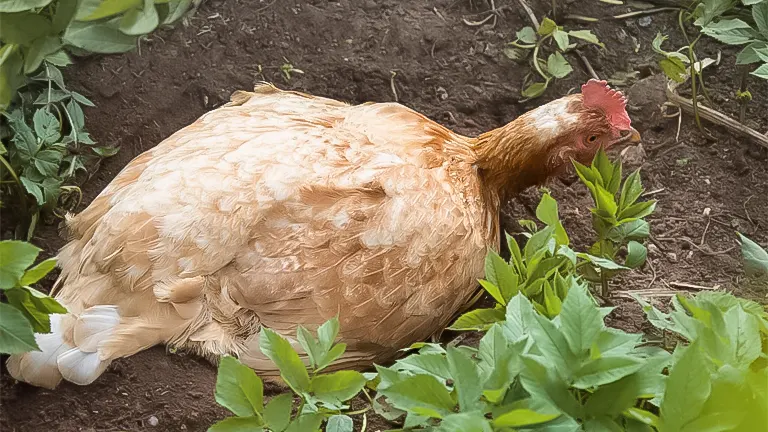
Incorporating diatomaceous earth into the chicken coop environment is a strategy employed by many to combat persistent parasitic challenges, including invasions by red mites and lice, which can significantly impact the well-being of poultry. This natural substance is lauded by a considerable segment of the backyard chicken-keeping community for its effectiveness, leading them to apply it generously both within the coop itself and in the surrounding run areas.
List of Benefits and Safe Usage of Diatomaceous Earth for Chickens:
- What Constitutes Diatomaceous Earth Powder?
- What does “Food Grade” Diatomaceous Earth Mean?
- Benefits of Diatomaceous Earth for Chickens
- Is Diatomaceous Earth Safe? Understanding the Risks and Precautions
- Safe Usage and Considerations
However, the application of diatomaceous earth is not without its detractors and is the subject of considerable debate. A portion of the poultry-keeping community views it as a double-edged sword; while it can be an effective means of pest control, there are concerns regarding its potential negative health implications for the flock. The inhalation of diatomaceous earth particles, for instance, could pose respiratory risks to both chickens and their caretakers, casting a shadow over its perceived benefits.
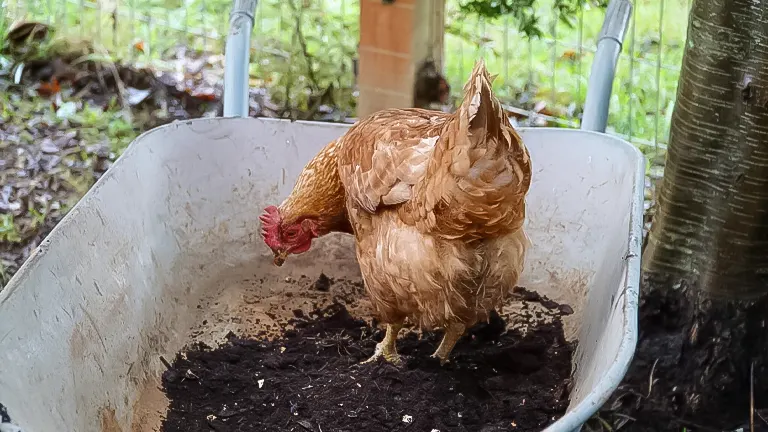
Amidst this controversy, there exists a middle ground occupied by some chicken keepers who acknowledge the utility of diatomaceous earth but advocate for a more measured approach to its use. They emphasize the importance of strategic application, suggesting that it can indeed be part of a holistic pest management strategy if used judiciously and within what they determine to be safe parameters. This cautious stance reflects a balanced consideration of both the potential advantages in pest control and the imperative to safeguard the health and well-being of the flock.
What is Diatomaceous Earth?
Diatomaceous Earth is a naturally occurring, soft, siliceous sedimentary rock that is easily crumbled into a fine white to off-white powder. It is made from the fossilized remains of diatoms, a type of hard-shelled algae. For poultry care, it’s crucial to use food-grade DE, which is safe for animals to consume, as opposed to filter-grade DE, which is used in industrial applications and can be harmful to breathe.
1. What Constitutes Diatomaceous Earth Powder?
Diatomaceous earth powder is essentially composed of the fossilized remains of diatoms, which are a type of microscopic algae. The primary component of these fossils is almost entirely amorphous silicon, a notable distinction given its relevance to health and safety considerations. The significance of amorphous silicon lies in its contrast to the crystalline form of silica, which is known to be a potential health hazard.

Crystalline silica exposure is linked to silicosis, a serious lung disease that can lead to lung cancer. This highlights the importance of selecting diatomaceous earth products with minimal crystalline silica content. In the United States, a diatomaceous earth product is deemed safe for use if it contains less than 2% crystalline silica, a standard that is still considered high by the regulations of other countries.
Furthermore, high-quality diatomaceous earth should be free from any additives or fillers, such as antibiotic powders or other bulking agents, which are often found in lower quality products to increase volume.
2. What does “Food Grade” Diatomaceous Earth Mean?
When it comes to “food grade” diatomaceous earth, this classification signifies a product that has undergone a more rigorous filtration process compared to its non-food grade counterparts. Non-food grade diatomaceous earth, which might be labeled as filter, pool, or garden grade, is utilized in various industrial applications, including the production of dynamite.
Due to its toxicity, it is unsafe for consumption by humans, animals, and poultry. Therefore, it’s crucial to ensure the diatomaceous earth used around food-producing animals or for personal health purposes is explicitly labeled as “food grade.”
In terms of functionality, diatomaceous earth combats external parasites such as red mites and lice through a mechanism that involves the dehydration of these pests. It achieves this by absorbing the oils and fats from the insect’s exoskeleton, a process facilitated by the desiccant nature of diatomaceous earth and the microscopic sharp edges of its particles, which are abrasive.

This combination effectively leads to the drying out and subsequent death of the parasites. For diatomaceous earth to maintain its efficacy, it must be kept dry and undisturbed, ensuring its action against parasites is uninterrupted.
3. Benefits of Diatomaceous Earth for Chickens
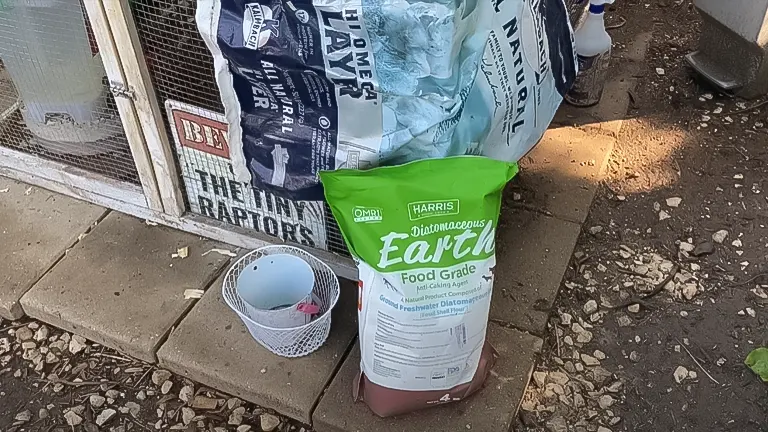
- Parasite Control: One of the primary reasons I started using DE was for its reputed efficacy in controlling external parasites like mites, lice, and fleas. I sprinkled DE in my chickens’ dust-bathing areas and noticed a significant reduction in the presence of these pests. It’s believed that the microscopic sharp edges of DE particles cut through the exoskeletons of these parasites, effectively dehydrating and killing them.
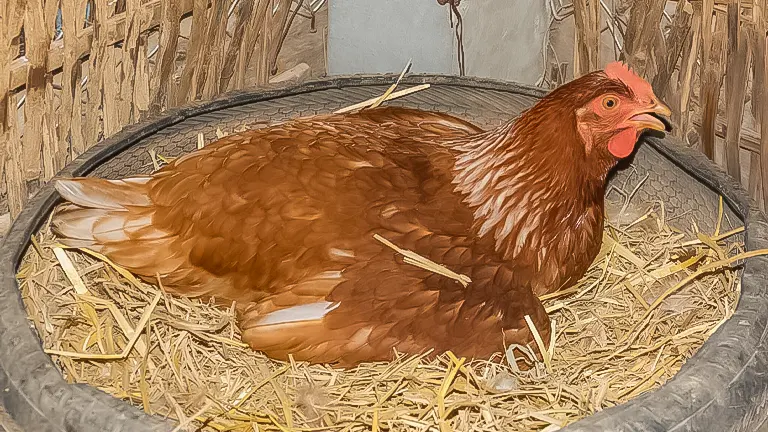
- Dietary Supplement: DE is also rich in minerals, including silica, magnesium, calcium, sodium, and iron, which are beneficial for chicken health. I began mixing a small amount of DE with my flock’s feed to promote stronger eggshells and overall better health. Anecdotally, I observed improvements in eggshell quality and a more vibrant flock within a few weeks of incorporating DE into their diet.
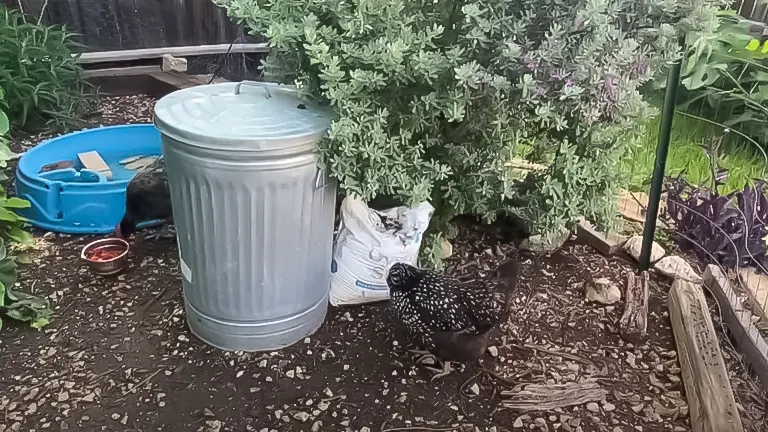
- Odor and Moisture ControlAdding DE to the coop bedding has helped in reducing odor and moisture levels. This not only makes for a more pleasant environment but also reduces the risk of diseases and parasites that thrive in damp conditions. My coop stays fresher longer, and my chickens seem to enjoy their cleaner living space.
4. Is Diatomaceous Earth Safe? Understanding the Risks and Precautions
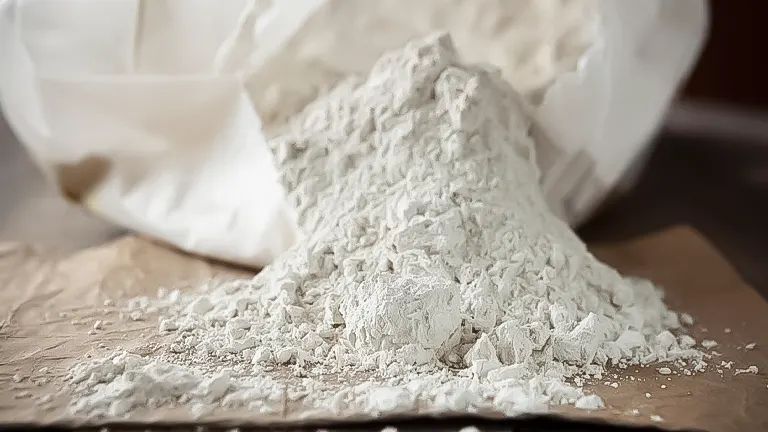
- Diatomaceous Earth (DE) is generally considered safe when it contains a high percentage of amorphous silica and a low percentage of crystalline silica. The primary safety concern is related to the inhalation of its dust particles.
- Research involving mice that inhaled diatomaceous earth for an hour daily over a year showed an increased rate of lung cancers, indicating that prolonged and consistent exposure might be harmful.
- For those of us raising chickens, such an intense level of exposure is unlikely, and with proper administration, our chickens should also remain unexposed. However, DE is a very fine and dusty powder that can easily disperse into the air if not handled with care.
- Gail Damerow, in “The Chicken Health Handbook,” notes that diatomaceous earth particles could adhere to chickens’ lungs, potentially causing respiratory issues. It’s important to note, however, that it’s the crystalline silica in DE, rather than the amorphous silica, that’s linked to respiratory problems.
- It’s crucial to apply and use DE in a manner that minimizes the risk of inhalation by chickens. Below, you’ll find tips on how to do this safely.
- For chicken keepers to ensure their own safety, wearing a mask or some form of protection over the nose and mouth is advisable when using DE.
- A surgical mask isn’t necessary. Alternatives like a dust mask or even a scarf securely tied around the nose and mouth can offer significant protection against inhaling DE particles.
5. Safe Usage and Considerations
While DE offers many benefits, safe usage is paramount. Inhalation of DE dust can cause respiratory irritation in both humans and chickens, so I always take care to apply it in a well-ventilated area and avoid creating airborne dust. I also wear a mask for my own protection during application.
Pros and Cons Based on My Experience
Pros
- Effective in controlling external parasites
- Natural dietary supplement that supports overall health
- Helps in reducing coop odor and moisture
Cons
- Potential respiratory irritant if not used carefully
- Quantitative effectiveness on parasites can be hard to measure precisely
Final Concluding Thoughts: Is Diatomaceous Earth Worth It?
Diatomaceous Earth (DE) has proven to be an essential component in my natural approach to poultry care, offering significant advantages in terms of parasite management, nutritional enhancement, and coop cleanliness, which have positively impacted the wellbeing of my chickens. Its natural properties and versatility make it a preferable choice over chemical alternatives for me, despite the need for cautious use due to potential respiratory hazards.
Emphasizing the importance of selecting food-grade DE and applying it with care to avoid inhalation risks, I advocate for its use in any chicken keeper’s regimen for a healthier, happier flock. Based on my positive experiences, I strongly recommend exploring the benefits of DE, ensuring it’s integrated thoughtfully into your care practices. My flock’s improved condition is a testament to the efficacy of DE when used judiciously.
Frequently Asked Questions
- What is Diatomaceous Earth (DE), and how is it beneficial for chickens?
DE is a naturally occurring, powdery substance made from the fossilized remains of diatoms. It benefits chickens by controlling parasites, improving feed efficiency, and contributing to better overall health. - Is Diatomaceous Earth safe for all chickens?
Yes, food-grade DE is safe for chickens when used properly. It’s important to ensure the DE is food-grade to avoid harmful additives. - How does Diatomaceous Earth work against parasites in chickens?
DE works mechanically, not chemically. The microscopic sharp edges of DE particles cut through the exoskeletons of parasites like mites and lice, causing them to dehydrate and die. - Can Diatomaceous Earth be added to chicken feed?
Yes, adding a small amount of food-grade DE to chicken feed can help promote digestion and deter internal parasites. However, it should not exceed 2% of the total diet. - How do I apply Diatomaceous Earth in the chicken coop?
DE can be sprinkled in the bedding, around the coop, and in dust-bathing areas. It should be applied lightly and evenly, avoiding creating airborne dust. - Are there any respiratory risks associated with using Diatomaceous Earth?
Inhaling DE can cause respiratory irritation. It’s advisable to wear a mask when applying it and to ensure that neither you nor the chickens are in close proximity to airborne DE particles. - How often should I apply Diatomaceous Earth in my coop?
This can vary depending on the level of infestation and environmental conditions, but a general recommendation is to apply it monthly or as needed to control pests. - Can Diatomaceous Earth help with odor control in the coop?
Yes, DE can help absorb moisture and reduce odors in the chicken coop when applied to the bedding and floor areas. - What’s the difference between food-grade and filter-grade Diatomaceous Earth?
Food-grade DE is safe for consumption by animals and humans, while filter-grade (or industrial-grade) DE is processed differently and can be harmful if ingested or inhaled due to higher silica content. - Where can I purchase food-grade Diatomaceous Earth?
Food-grade DE is available at many feed stores, garden centers, and online retailers. Ensure the product is labeled as “food-grade” to guarantee its safety for use with chickens.
These FAQs provide a foundation for understanding how DE can be a beneficial and safe product for chicken care, focusing on its proper application and handling to maximize benefits while minimizing risks.
We’re eager to learn from your journey! If you’ve used Diatomaceous Earth with your chickens, please share your stories and insights in the comments section below. Your experiences and tips on the benefits and safe usage of Diatomaceous Earth can greatly assist fellow poultry enthusiasts in making knowledgeable choices for their flocks. Whether it’s about parasite control, dietary supplementation, or maintaining a clean coop, your input is invaluable to our community!

Edward Smith
Forestry AuthorWoodworking is about more than crafting; it's a harmonious connection with nature, mastering tools, and preserving our environment. I'm here to share my knowledge and experiences with you, forging a future where we can embrace wood's beauty and utility while safeguarding our forests' health and diversity.













Leave your comment